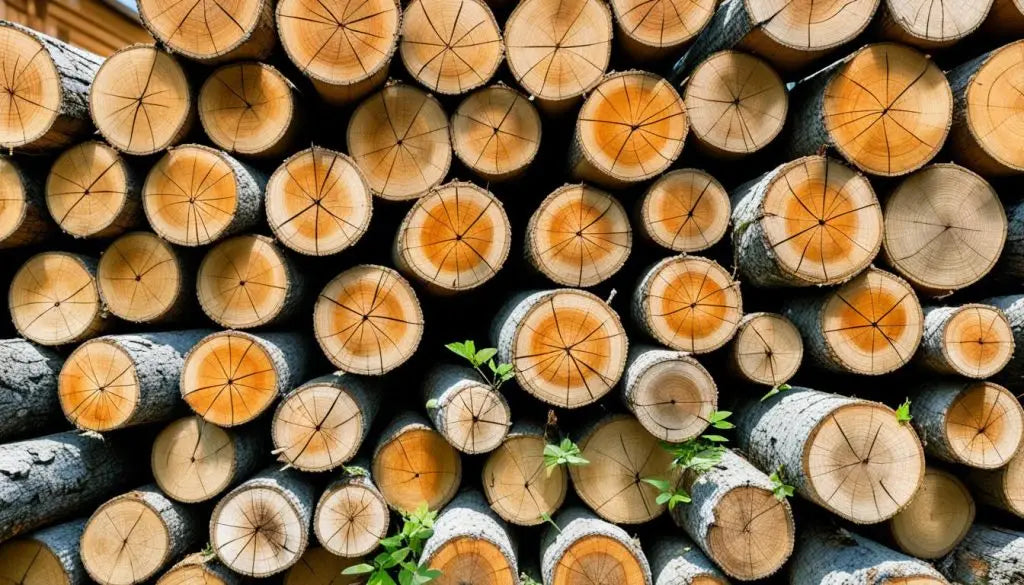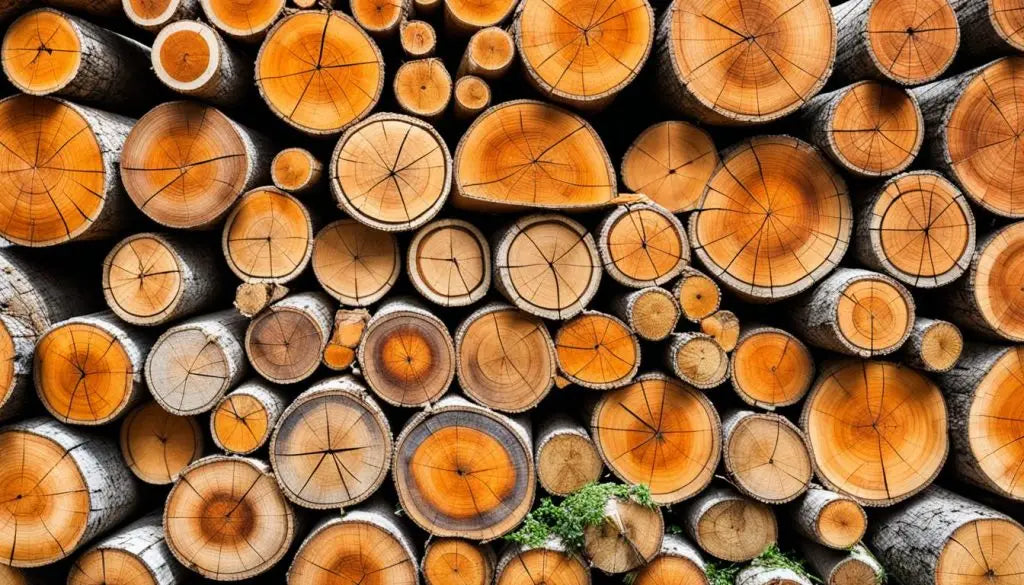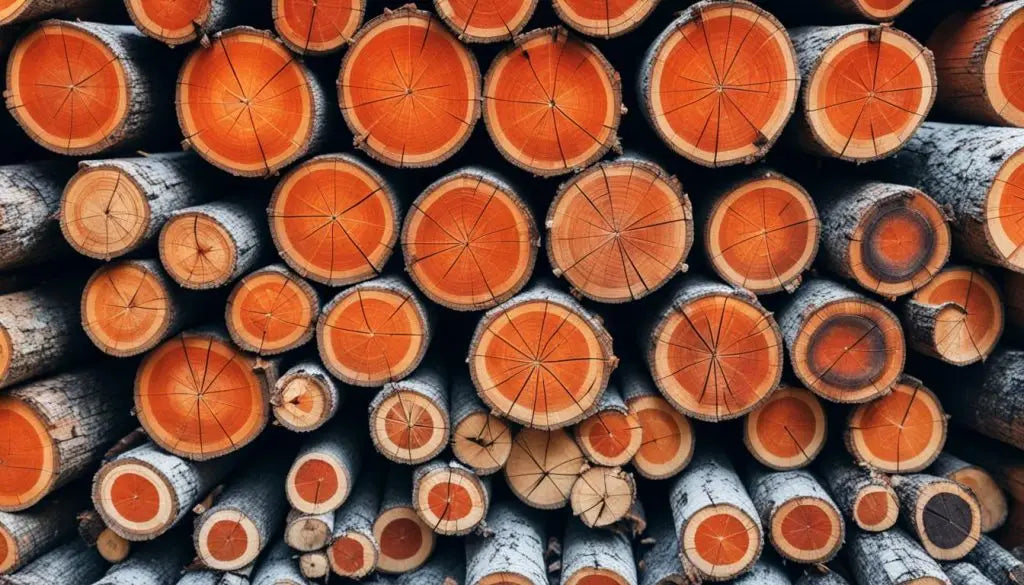Imagine a crisp autumn evening with the crackle of a fire in the air. You and your loved ones are around your outdoor fire pit. The right firewood turns this scene real. Choosing the best logs is essential for a warm atmosphere and steady, enjoyable fire with little smoke.
Choosing your firewood is more than picking any piece of wood. The burnability, seasoning, and moisture level of logs matter a lot. Quality, well-seasoned firewood leads to hotter burns and less smoke. This makes every gathering, or quiet night under the stars, better with a consistent fire.
Key Takeaways
- Oak wood produces about 24 million BTUs per cord and takes one to two years to fully season.
- Hickory wood averages at 28.5 million BTUs per cord and needs at least one year to properly season.
- Apple wood burns at approximately 26.6 million BTUs per cord and requires a minimum of one year to dry.
- White Ash wood, with about 23.6 million BTUs per cord, fully seasons in six months and burns clean with no smoke.
- Soft woods burn quickly and generate a lot of smoke, making them less ideal for indoor fireplaces or wood stoves.
For more details on the best firewood for your fire pit, check out this helpful guide.
What Makes Wood Burnable for Outdoor Fire Pits
Understanding what makes wood burnable for outdoor fire pits is key. Factors like wood density, seasoning, and moisture content are crucial. They help create a consistent flame that lasts longer.
Understanding Wood Density
Wood density shows how compact wood fibres are. Dense woods, like oak and maple, burn slower. They are high-quality firewood because they make fires last longer. You won't need to refuel often, making your fire pit gatherings uninterrupted.
Importance of Wood Seasoning
Seasoning dries the wood to lower its moisture. Freshly cut wood, or 'green wood,' has over 20% moisture. This leads to a lot of smoke and less heat. Meanwhile, seasoned fire logs under 20% moisture burn better. They make your outdoor fire pit experience hotter and cleaner.
Moisture Content in Firewood
Moisture content is key for burnable firewood. For long-lasting fire logs, it should be under 20%. High moisture stops good combustion, causing less heat and more smoke. Dry firewood provides a more efficient burn. It keeps your outdoor fire pit fun and smoke-free.
The Importance of Seasoned Firewood
Seasoned firewood is key for a good outdoor fire. It has less moisture, making your fire pit better. This means more warmth and enjoyment for everyone.

Benefits of Using Seasoned Wood
Seasoned logs make outdoor fires cleaner and hotter. These logs have low moisture, under 20%, which means more heat. You get a stronger fire with less smoke. Plus, they light up easily, making your fire pit gatherings smooth.
How to Identify Seasoned Wood
To pick seasoned firewood, look for a few signs. Here’s what matters:
- Dryness: Seasoned logs look drier than new ones.
- Cracks at the Ends: You'll see cracks on the ends of seasoned logs.
- Lighter Weight: They're lighter than before because water is gone.
Choosing kiln dried or seasoned wood means less smoke and more heat. It makes your outdoor fires more enjoyable.
Best Logs for Outdoor Fire Pits
When looking for the top logs for outdoor fire pits, picking high BTU hardwood is key. Hardwood ash logs are among the best. They last long, burn efficiently, and provide lots of heat. They make your outdoor space warm and inviting.
Oak and hickory are top choices for their burn time and nice smell. These woods make your outdoor moments special. Ash logs are also great because they smoke less and give steady heat.
Choosing sustainable logs is vital for the environment. It's important to get hardwood from forests that are looked after well. This helps our planet. Selecting certified ash logs means good performance without harming nature.
Top Hardwoods for Your Fire Pit
Finding the best hardwood for your fire pit is key for a great outdoor experience. Good quality hardwoods burn well, make less smoke, and create a cozy setting. Here are the top hardwoods to think about:
Oak Logs
Oak logs are excellent for fire pits due to their long burn and high heat. They produce about 24 million BTUs per cord. Oak is perfect for keeping you warm outdoors.
Maple Firewood
Maple firewood is loved for its nice smell and strong heat production. It gives off around 26.6 million BTUs per cord. This wood ensures a warm, clean fire for outdoor events.
Apple Wood
Apple wood is valued for its smell and is great in smoking meats or in fire pits. It burns hot and clean, making evenings outside special. It's top-notch for heating outdoors.
White Ash Logs
White ash logs are known for burning well and offering about 23 million BTUs per cord. They produce little smoke and ash, and season in just six months. These logs guarantee a steady, clean fire.
Top Softwoods for Outdoor Fire Pits
Choosing the right softwoods can make your fire pit experience better. Softwoods are good for starting fires and adding nice smells. Here are some top choices and what makes them special.
Pine as Kindling
Pine is a top pick for softwood kindling. It lights up fast, making it great for beginning your fire. But, use it in small amounts as it can burn quickly and make lots of smoke. When using seasoned fire logs of pine, make sure they are fully dry to cut down on smoke.
Cedar for Aromatic Fires
Cedar gives off a lovely, calming smell. It's a fantastic choice for your fire pit. It's also eco-friendly fire pit logs, known for its nice scent and good warmth. Add cedar little by little to keep the scent pleasant without it being too strong.
Fir and Spruce Variants
Fir and spruce are good for a nice evening by the fire. These softwoods burn well when they're seasoned fire logs. They might not be as hot as hardwoods, but they're ideal for a cosy atmosphere by your fire pit.
Sustainable Log Options for Outdoor Fire Pits

When picking sustainable log options for your fire pit, think about eco-friendly picks. These should burn well. Hardwoods like ash, oak, and birch make your fires warm and kind to the planet.
Ash stands out because it's dry, burning effectively even when new. You can count on it. Oak needs two years to dry but then burns slowly, keeping you warm for longer. By adding fast-burning birch to oak or elm, you get a perfect mix of heat and duration.
For greener choices, get hardwoods from forests that are looked after well. If the wood has a certification, it means it's cut down responsibly. Kiln-dried logs, like those from hillside woodfuels, burn brilliantly and show care for our planet. Using these makes your outdoor heating powerful but eco-friendly.
Softwoods are usually not preferred because they can spit and make a lot of soot. Yet, they can work for eco-friendly fire pit logs if used wisely. But, stay away from woods like horse chestnut and willow. They're too watery and don't burn well.
| Wood Type | Water Content | Burn Efficiency |
|---|---|---|
| Ash | Low | Burns green, high efficiency |
| Oak | Needs 2 years seasoning | Slow, long-lasting burn |
| Birch | Moderate | Easy to burn, mix with slow burners |
| Holly, Hornbeam, Rowan, Sycamore, Yew | Varied | Good burning |
| Horse Chestnut, Larch, Pine, Poplar, Spruce, Sweet Chestnut, Walnut, Willow | High | Less efficient, avoid burning |
By choosing sustainable log options wisely, you'll enjoy green and efficient fires. This enhances your outdoor moments. It also supports a greener future. You keep your impact on the earth low while enjoying the warmth of your fire pit.
Eco-friendly Fire Pit Logs
Choosing eco-friendly logs for your fire pit is good for the planet and your outdoor fun. Bamboo logs and recycled compressed logs are top picks. They are good for the environment and suit different needs.
Bamboo Logs
Bamboo logs are a great choice because they're sustainable and burn efficiently. They grow much quicker than regular trees. Plus, they make less smoke and ash, keeping your fire pit clean and enjoyable. They're also light and easy to use, perfect for any outdoor spot.
Recycled Compressed Logs
Recycled compressed logs are made from sawdust and wood chips. They offer a green way to enjoy a fire. These logs burn longer and create less smoke, making for a better fire experience. They also recycle materials that would otherwise go to waste.
| Type of Log | Renewability | Smoke Emission | Burn Time | Handling Ease |
|---|---|---|---|---|
| Bamboo Logs | High | Low | Moderate | Easy |
| Recycled Compressed Logs | High | Very Low | Long | Moderate |
Using bamboo or recycled logs means living more sustainably. Both are efficient, eco-friendly choices for your fire pit.
Why Kiln Dried Logs are Recommended
Kiln dried logs are great for outdoor fire pits because of their many benefits. They have less moisture and burn better than traditionally air-dried wood. We'll look at why kiln drying is better, focusing on moisture and efficiency.

Benefits of Kiln Drying
Kiln dried logs have low moisture, usually under 20%, so they burn really well. They are dried with controlled heat, making them ready faster than air-dried ones. This means more heat, less smoke, and cleaner burning.
Comparison with Air-dried Logs
Air-dried logs take longer to dry because they depend on the weather. Kiln dried logs, on the other hand, dry faster and have steady moisture levels. They're better because they burn cleaner and hotter, making them perfect for efficient and long-lasting fires.
| Aspect | Kiln Dried Logs | Air-dried Logs |
|---|---|---|
| Drying Time | Weeks to a few months | Several months to over a year |
| Moisture Content | Below 20% | Variable, often above 20% |
| Consistency | High | Variable |
| Pest and Mould Free | Yes | No |
| Burn Efficiency | High | Moderate |
| Soot and Smoke Production | Low | Higher |
How to Stack and Store Firewood
Stacking and storing firewood properly keeps it in good shape. Doing this right means it burns well when you need it. The way you stack firewood helps it stay dry and season well, making for better fires.
Proper Stacking Techniques
Begin by picking a dry, shaded spot for storage. Keep the wood off the ground by using pallets or concrete blocks. This prevents soil moisture and pests from getting in. Stack the wood in a single row with a bit of a tilt. This helps rainwater slide off instead of soaking in. Put a tarp over the top to protect from rain, but let the sides breathe for air flow.
Importance of Air Circulation
Good air flow is key for stored firewood. It dries the wood more, lowering its moisture. This makes it seasoned fire logs. Without enough air, your wood could get mouldy or mildewy. That would make it bad for burning. Spaces between the logs help air move through the whole stack.
Wood Storage Safety Tips
Keep your firewood stack safe by checking it for bugs or animals. Fix any bug problems right away. Also, keep the area around your woodpile clear. This reduces fire risks and makes it easy to get to. Store the wood away from your house to keep pests out. Make sure the wood pile stays steady to avoid accidents.
| Storing Firewood Tips | Benefits |
|---|---|
| Use pallets or concrete blocks | Keeps wood off the ground, preventing moisture |
| Cover the top, leave sides open | Protects from rain while allowing air circulation |
| Inspect regularly for pests | Ensures wood remains pest-free and suitable for burning |
| Maintain a clear zone around the stack | Reduces fire hazards and improves accessibility |
Piling Strategies for Effective Fire Pit Fires
Getting your fire pit to burn properly is more than just choosing logs. It's also about how you stack them. Good stacking techniques can help your fire burn better and make your time outdoors more fun. Knowing the best method to use can really improve the experience at your fire pit.
The Teepee Method
The Teepee Method stacks logs in a shape like a teepee. This helps air move well, making the fire burn quickly and well. It's great for starting fires since it's easy to light, making this method very dependable for fire pits.
The Log Cabin Layout
The Log Cabin Layout makes your fire pit stable and effective. Logs are stacked to look like a cabin. This pattern keeps the heat steady, allowing the fire to burn longer. It is great for when you need your outdoor fire to last a long time.
The Lean-To Strategy
The Lean-To Strategy is perfect for windy conditions. You prop one log against another to make a sheltered space. This way, the fire is protected from the wind but still gets enough air. It's a solid choice for keeping your fire going when the weather isn't ideal.
The Star Formation
The Star Formation saves fuel by having logs stick out from the centre, like a star. As the tips burn, you can push the logs closer together. This keeps the fire going well and saves wood. It's a very cost-effective way to keep your fire at the right heat.
FAQ
What are the best logs for outdoor fire pits?
The best logs for outdoor fire pits include hardwoods like oak and hickory. Maple and ash also provide a lasting burn, warmth, and nice smells. It's important to choose logs that are kind to the environment.
Why is wood density important for fire pit logs?
Dense hardwoods such as oak and maple burn longer and hotter. This makes them perfect for long, enjoyable fires outdoors.
Why is seasoning important for firewood?
Seasoned wood, dried to have less than 20% moisture, burns better. It gives off more heat, less smoke, and lights easier. This makes your fire pit experience much better.
How can I identify seasoned wood?
Look for wood that's dry, has cracks at the ends, and feels lighter. When knocked together, it should sound hollow. Seasoned wood burns well with little smoke.
What are the benefits of using kiln-dried logs?
Kiln-dried logs burn efficiently thanks to their low moisture level, often under 20%. They're also clean from pests and mould. Plus, they don't need much time to season.
What are some sustainable log options for outdoor fire pits?
Choose logs from forests that are looked after well. Bamboo logs and recycled logs from sawdust and wood chips are also green choices.
Which hardwoods are recommended for fire pits?
Oak, maple, apple wood, and white ash logs are top choices for fire pits. They burn long and hot, adding a pleasant smell to your outdoor space.
Can softwoods be used in outdoor fire pits?
Yes, softwoods like pine, cedar, fir, and spruce are okay for fire pits. Pine is great for starting fires, and cedar smells nice. But, they burn quicker and smoke more than hardwoods.
How should firewood be stacked and stored?
Keep firewood off the ground and covered to stay dry. Good air flow helps it season further. Use pallets or concrete blocks for pest control and to keep the wood dry.
What are some effective piling strategies for fire pits?
For good burning, try the Teepee, Log Cabin, Lean-To, or Star methods. They help with lighting and keeping the fire going steadily.

